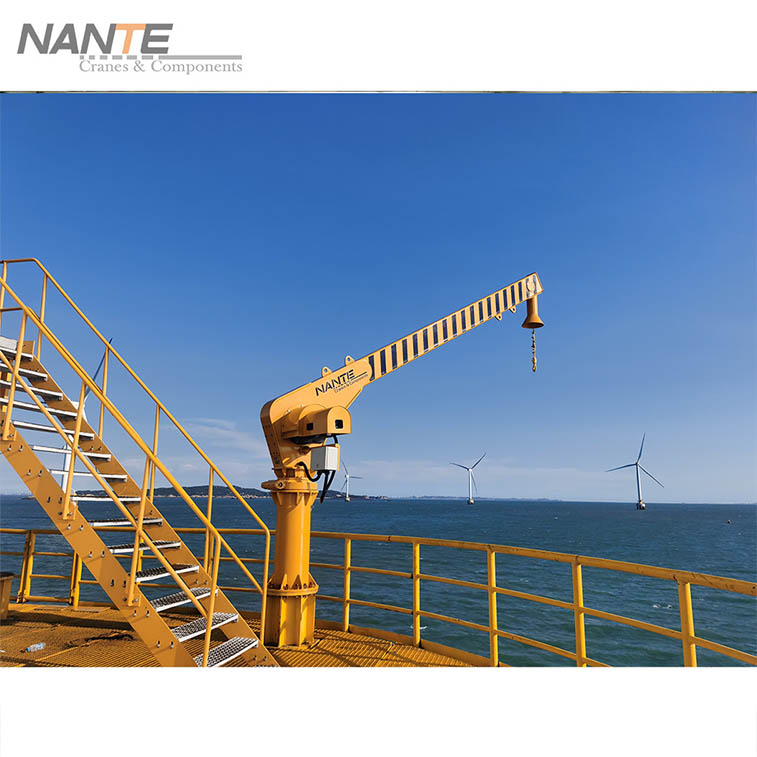Key Safety Tips for Operating Offshore Cranes Securely
Date: 2024-07-30 Share:
Ensuring the safe operation of offshore cranes is essential to protect both the operators and the environment around them. Offshore crane operations come with many challenges that necessitate strict adherence to safety protocols to reduce risks and prevent accidents. This article focuses on offering detailed guidance on important safety tips for operating offshore cranes, ensuring that these operations are carried out both effectively and safely.

Understanding the Importance of Safety in Offshore Crane Operations
The Risks Involved in Offshore Crane Operations
Operating offshore cranes involves complex operations in a harsh and unpredictable environment. The risks include mechanical failures, human errors, adverse weather conditions, and sea state variations. Considering these factors, it is paramount to prioritize safety measures to prevent accidents and injuries. Failure to address these risks adequately can lead to catastrophic incidents, including equipment damage, environmental hazards, and loss of life.
Regulatory Requirements and Standards
Various regulatory bodies govern offshore crane operations, stipulating mandatory safety standards and guidelines. These regulations aim to ensure that all aspects of crane operation—from equipment maintenance to operator training—meet established safety criteria. Compliance with these regulations not only enhances operational safety but also ensures legal protection for companies. Organizations must stay updated with changes in regulations to maintain compliance and promote a culture of safety.
As one of the famous brands in the production of winches, cranes and crane parts, Nante Crane is dedicated to research and development of lifting and material handling technologies. We adopt innovative ideas and design in developing new products and services. Backed up by a wealth of industrial experience, we can provide customers with high quality lifting equipment and components.
Comprehensive Training and Certification
Types of Training Programs Available
To operate offshore cranes securely, comprehensive training is essential. Training programs typically cover both theoretical knowledge and practical skills needed for safe crane operations. Courses may include topics such as understanding crane mechanics, load management, emergency response procedures, and safety compliance. Some training programs are more advanced, focusing on specific types of cranes or operational scenarios that operators might encounter.
Certification Requirements and Guidelines
Securing the appropriate certification is crucial for guaranteeing safe offshore crane operations. To achieve certification, operators are typically required to pass both written and practical examinations that showcase their proficiency. This certification hinges on adhering to industry standards and is commonly renewed at regular intervals to maintain ongoing compliance and ensure knowledge retention. The guidelines for certification can differ but generally encompass a combination of training hours, hands-on experience, and skill assessment.
Ongoing Education and Skill Refreshment
The dynamic nature of offshore crane operations necessitates ongoing education and skill refreshment. Operators should participate in regular refresher courses and training updates to stay current with technological advancements and procedural changes. Continuing education helps operators to adapt to new challenges and ensures sustained high standards of safety. This commitment to continuous learning helps minimize the likelihood of errors and enhances overall operational safety.
Pre-Operational Safety Checks
Inspecting Equipment Before Use
Mechanical Components
Before beginning any operation, it is essential to inspect all mechanical components of the offshore cranes. This includes checking for wear and tear, ensuring that all moving parts are well-lubricated, and verifying that the structural integrity of the crane is intact. Regular mechanical checks help identify potential issues before they lead to failures, thereby enhancing safety and operational efficiency.
Safety Devices and Controls
Ensuring that all safety devices and controls are functioning correctly is critical for safe crane operation. This involves testing emergency stop buttons, load indicators, and any other automated safety features. Regular checks and maintenance of these safety devices can prevent accidents and ensure that the crane operates as intended during critical moments.
Reviewing Environmental Conditions
Weather Considerations
Weather plays a crucial role in offshore crane operations. Unfavorable conditions like strong winds, intense rainfall, or storms can elevate the risk of accidents. It’s vital to keep an eye on weather forecasts and organize operations accordingly, delaying tasks if needed to maintain safety. Operators must be trained to swiftly and efficiently identify and react to shifting weather conditions.
Sea State
The state of the sea also plays a crucial role in crane operation safety. Rough seas can lead to instability and increase the difficulty of managing loads safely. Before starting operations, operators should assess the sea state and determine if it is conducive to safe crane operation. Procedures should be in place to halt operations if sea conditions become too dangerous.
By following these outlined safety measures, offshore crane operations can be conducted securely, minimizing risks and ensuring the well-being of personnel and the environment. Adhering to stringent safety protocols not only mitigates potential hazards but also fosters a culture of safety and efficiency in offshore operations.
Communication and Coordination
Establishing Clear Communication Protocols
Effective communication is essential for safe offshore crane operations. Establish clear communication protocols to ensure all team members understand their roles and responsibilities. Use standard hand signals and verbal commands to avoid misunderstandings during critical operations. Conduct regular safety meetings to discuss potential risks and review safety procedures. Implementing these protocols helps create a cohesive team that can respond quickly to any issues that arise.
Utilizing Technology for Better Coordination
Enhancing coordination efforts during offshore crane operations can be achieved by leveraging technology. Maintaining real-time communication is possible through the use of two-way radios, intercom systems, and crane monitoring software. Advanced technologies like GPS and load monitoring systems offer vital data on crane performance and environmental conditions. This information aids operators in making informed decisions and adjusting operations as necessary, thus ensuring greater safety and efficiency.
Safe Lifting Practices
Calculating Load Limits and Centering Loads Safely
Accurately calculating load limits is crucial for safe lifting practices. Understand the crane’s load capacity and ensure that it is not exceeded during operations. Incorrect load calculations can lead to equipment failure and accidents. Always double-check the weight of the load and ensure it is centered correctly to maintain stability. Proper load management includes knowing the crane’s load chart, which provides detailed information on load limits at different boom lengths and angles.
Use of Tag Lines and Slings to Ensure Stability
Using tag lines and slings is vital in maintaining the stability of loads during lifting operations. Tag lines help control the movement of the load, preventing it from swaying or spinning, which could cause accidents. Ensure that slings are of appropriate strength and are positioned correctly to distribute the load evenly. Regular inspection of slings for wear and tear is necessary to guarantee their reliability. Proper use of these tools can significantly enhance safety and prevent incidents.
Avoiding Overloading the Crane
Overloading the crane is one of the most dangerous practices and can lead to catastrophic failures. Always respect the crane’s load limits and avoid any attempt to lift loads beyond its capacity. Overloading not only risks the integrity of the crane but also endangers personnel and equipment. Establish strict protocols to prevent overloading, such as checking load weights meticulously and confirming that they are within the crane’s safe operational limits. Educate all personnel on the risks associated with overloading to ensure everyone is aware of the potential dangers.
Adhering to these detailed safety guidelines will ensure that offshore cranes function safely and effectively, reducing hazards and fostering a secure workplace for everyone concerned.
Emergency Preparedness Procedures
Developing an Emergency Response Plan
Proactively preparing for emergencies is a crucial aspect of safely operating offshore cranes. Developing a comprehensive emergency response plan helps address potential incidents effectively and rapidly. This plan should outline detailed procedures for various emergency scenarios, such as equipment failures, severe weather conditions, and health emergencies. Clear guidelines help minimize confusion during an actual emergency, allowing for a prompt and organized response that can mitigate risks and reduce the severity of any incidents.
Roles and Responsibilities
A well-defined emergency response plan assigns specific roles and responsibilities to each team member. Knowing who is responsible for what tasks ensures swift action during critical moments. For example, designating a person to communicate with emergency services can save valuable time. Additionally, clearly defining the roles of operators, support teams, and safety officers ensures that every member understands their duties and can act decisively in an emergency situation.
Emergency Drills and Simulations
Conducting regular emergency drills and simulations is necessary for preparing employees to handle real-life crises effectively. These drills provide practical experience, reinforcing what was learned during safety training sessions and enabling team members to practice their emergency roles in a controlled environment. Simulating different emergency scenarios, such as sudden mechanical failures or severe weather conditions, helps identify potential weaknesses in the response plan and improves the team’s readiness and efficiency.
Access to First Aid and Medical Assistance
Ensuring immediate access to first aid and medical assistance is crucial for the safety of personnel working with offshore cranes. A well-stocked first aid kit should always be accessible on-site, containing supplies appropriate for treating common injuries. Additionally, having staff trained in first aid can speed up the delivery of initial care until professional medical help arrives. Implementing a clear protocol for contacting medical services guarantees quick assistance and reduces potential health risks following any accidents or incidents.
As one of the famous crane production and manufacturing brands, Nante Crane is committed to helping our clients reduce investment cost, improve production efficiency, and economize energy consumption. Nante Crane’s main products include industrial cranes, offshore cranes, Launching Crane, electric hoists, crane travel unit, mobile power supply system etc. with reliable and excellent performance.
Regular Maintenance and Inspections
Scheduled Maintenance Checks
Regular maintenance and inspections are foundational elements for the safe operation of offshore cranes. Scheduled maintenance checks help identify and rectify potential issues before they escalate into significant problems, ensuring that the equipment remains in good working condition. A well-maintained crane reduces the likelihood of mechanical failures, enhancing both safety and operational efficiency. Keeping a detailed log of all maintenance activities helps track the crane’s condition over time and ensures that all necessary procedures are followed consistently.
Mechanical Integrity
Maintaining the mechanical integrity of offshore cranes involves systematically checking all mechanical components. This includes inspecting the crane’s boom, wire ropes, pulleys, and hooks for signs of wear and tear or damage. Lubricating moving parts as required and replacing any worn-out components promptly ensures the crane functions smoothly and reduces the risk of mechanical failure during operations. Regular inspections help address issues preemptively, maintaining the reliability and safety of the crane.
Electrical Systems
The electrical systems of offshore cranes also require diligent inspection and maintenance to ensure operational safety. Checking all electrical components, including wiring, control panels, and safety systems, is crucial to prevent electrical failures that could lead to serious accidents. Ensuring that all connections are secure, all systems are functioning correctly, and any faulty components are repaired or replaced promptly helps maintain the crane’s overall safety and performance.
In addition to producing and manufacturing cranes, Nante Crane has achieved breakthroughs in core technology and has the ability to manufacture core components, which are widely used in more than 20 professional fields such as advanced manufacturing, metal processing, aerospace, etc. Nante Crane is committed to the research and development and manufacturing of handling machinery and technology.
Reporting and Addressing Deficiencies Promptly
Promptly addressing and reporting any deficiencies identified during inspections is essential for maintaining the operational safety of offshore cranes. Promote a culture where operators and maintenance personnel immediately report any issues they notice. Quick action on these reports, whether it involves making repairs, replacing defective parts, or taking the crane out of service if necessary, reduces risks and prevents potential accidents. Establishing clear communication channels for reporting and addressing deficiencies ensures that all issues are managed efficiently and effectively.
By integrating these emergency preparedness procedures, regular maintenance, and inspection routines into daily operations, companies can significantly enhance the safety and reliability of offshore cranes. Prioritizing these practices ensures not only the well-being of personnel but also the efficiency and effectiveness of offshore crane operations.
 English
English






